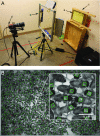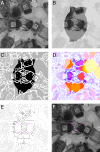Automated monitoring of behavior reveals bursty interaction patterns and rapid spreading dynamics in honeybee social networks
- PMID: 29378954
- PMCID: PMC5816157
- DOI: 10.1073/pnas.1713568115
Automated monitoring of behavior reveals bursty interaction patterns and rapid spreading dynamics in honeybee social networks
Abstract
Social networks mediate the spread of information and disease. The dynamics of spreading depends, among other factors, on the distribution of times between successive contacts in the network. Heavy-tailed (bursty) time distributions are characteristic of human communication networks, including face-to-face contacts and electronic communication via mobile phone calls, email, and internet communities. Burstiness has been cited as a possible cause for slow spreading in these networks relative to a randomized reference network. However, it is not known whether burstiness is an epiphenomenon of human-specific patterns of communication. Moreover, theory predicts that fast, bursty communication networks should also exist. Here, we present a high-throughput technology for automated monitoring of social interactions of individual honeybees and the analysis of a rich and detailed dataset consisting of more than 1.2 million interactions in five honeybee colonies. We find that bees, like humans, also interact in bursts but that spreading is significantly faster than in a randomized reference network and remains so even after an experimental demographic perturbation. Thus, while burstiness may be an intrinsic property of social interactions, it does not always inhibit spreading in real-world communication networks. We anticipate that these results will inform future models of large-scale social organization and information and disease transmission, and may impact health management of threatened honeybee populations.
Keywords: barcode; burstiness; temporal network; tracking; trophallaxis.
Copyright © 2018 the Author(s). Published by PNAS.
Conflict of interest statement
The authors declare no conflict of interest.
Figures




References
-
- Charbonneau D, Blonder B, Dornhaus A. 2013. Social insects: A model system for network dynamics. Temporal Networks, Understanding Complex Systems, eds Holme P, Saramäki J (Springer, Berlin), pp 217–244.
-
- Christakis NA, Fowler JH. The spread of obesity in a large social network over 32 years. N Engl J Med. 2007;357:370–379. - PubMed
-
- Holme P, Saramäki J. Temporal networks. Phys Rep. 2012;519:97–125.
Publication types
MeSH terms
Grants and funding
LinkOut - more resources
Full Text Sources
Other Literature Sources

